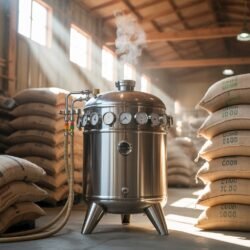Anaerobic fermentation is shaking up the specialty coffee world, offering producers a powerful tool to craft unique, high-value coffees. But as with any innovation, there’s a financial balancing act involved. Let’s dive into the real-world economics of anaerobic fermentation, exploring what it means for producers in terms of investment, market potential, and the risks they face.
The Price of Innovation
Switching to anaerobic fermentation isn’t as simple as flipping a switch. Producers need to invest in specialized equipment—think sealed fermentation tanks, temperature and pH monitoring systems, and sometimes even CO₂ injection setups. While some small-scale farmers have gotten creative with more affordable solutions, like using Grainpro bags or plastic barrels, these methods often come with less control over the process. Larger operations might opt for stainless steel tanks and automated monitoring, which can drive costs up but also increase the chances of producing consistent, high-quality lots.
Beyond the gear, anaerobic fermentation is a labor of love and patience. It demands more hands-on time, ongoing training, and a willingness to experiment and refine techniques. Producers must be ready to invest not just money, but also time and expertise.
The Allure of Market Premiums
So, why take the plunge? The answer lies in the potential for premium prices. Anaerobically fermented coffees are prized for their complex, often wine-like flavors and unique profiles. This rarity and quality can set a producer apart, opening doors to specialty buyers and high-value markets. Some experimental lots have even fetched record prices at auctions, turning heads and raising the bar for what coffee can be.
But the premium isn’t guaranteed. The market for these innovative coffees is still niche and can be unpredictable. Consumer tastes evolve, and what’s hot today might not be tomorrow. Producers need to build trust with buyers by delivering consistent quality and staying attuned to market trends.
Navigating the Risks
With great opportunity comes real risk. The increased investment in equipment and labor means that producers are putting more on the line with each batch. If something goes wrong—like contamination or spoilage—an entire lot could be lost, resulting in a significant financial hit.
There’s also the challenge of managing cash flow. Anaerobic fermentation extends the time from cherry to cup, requiring producers to cover operational costs for longer periods. This can be especially tough for small-scale farmers who may not have deep reserves.
Quality control is another critical factor. Anaerobic fermentation is sensitive to variables like temperature, pH, and timing. Any misstep can lead to off-flavors or spoilage, turning a potentially premium product into a loss.
The Bottom Line
Anaerobic fermentation is more than just a trend—it’s a strategic choice that can elevate a producer’s brand and bottom line. But it’s not without its challenges. Producers who are willing to invest in the right tools, build their expertise, and manage risks carefully are the ones most likely to thrive in this exciting new frontier of specialty coffee. For those ready to take the leap, the rewards can be as bold and complex as the coffees they create.


